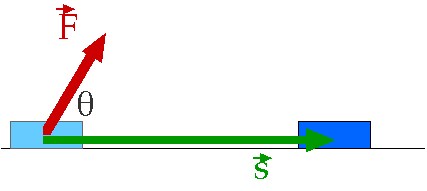

Work Done
by a Constant Force
W = F s cos 
Units?
[W] = N-m = J = joule named for James Prescott Joule
In the simplest case, when the force F and the displacement s are parallel, this definition of the work becomes
W = F s This is also an convenient way to recall the units; work is measured in N-m which is called joules ( J ).
But, in general, work is the component of the the force parallel to the displacement multiplied by the displacement,

W = F s cos
W = F s cos
You can think of work as the product of the component of the force parallel to the displacement multiplied by the displacement.
That means that a force perpendicular to the displacement does no work. As a block slides along a plane, the normal force does no work on it.
If the force is in the opposite direction of the displacement ( so the angle
is 180o ) the work done by that force is negative ( of course, the work is negative for 90o <
< 270o ). For the opposite direction as shown in the sketch here,
W = - F s We will see that positive work on an object increases its speed (and Kinetic Energy). Likewise, negative work on an object decreases its speed (and Kinetic Energy).
ToC Scalar Product Return to ToC, Ch7, Work and Energy (c) Doug Davis, 2001; all rights reserved